
Diplacus aurantiacus, the sticky monkey-flower or orange bush monkey-flower, is a flowering plant that grows in a subshrub form, native to southwestern North America from southwestern Oregon south through most of California. It is a member of the lopseed family, Phrymaceae. It was formerly known as Mimulus aurantiacus.

Phrymaceae, also known as the lopseed family, is a small family of flowering plants in the order Lamiales. It has a nearly cosmopolitan distribution, but is concentrated in two centers of diversity, one in Australia, the other in western North America. Members of this family occur in diverse habitats, including deserts, river banks and mountains.

Mimulus is a plant genus in the family Phrymaceae, which was traditionally placed in family Scrophulariaceae. The genus now contains only seven species, two native to eastern North America and the other five native to Asia, Australia, Africa, or Madagascar. In the past, about 150 species were placed in this genus, most of which have since been assigned to other genera, the majority to genus Erythranthe.
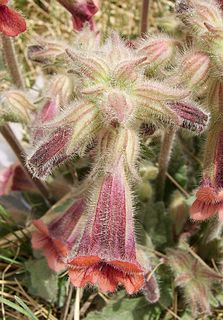
Rehmannia is a genus of seven species of flowering plants in the order Lamiales and family Orobanchaceae, endemic to China. It has been placed as the only member of the monotypic tribe Rehmannieae, but molecular phylogenetic studies suggest that it forms a clade with Triaenophora. Contrary to the immense majority of the taxa of Orobanchaceae, Rehmannia is not parasitic.

Diplacus rupicola, the Death Valley monkeyflower, is a flowering plant in the family Phrymaceae.

Phryma leptostachya, or lopseed, is a perennial herb of the genus Phryma. When distinguished from Phryma oblongifolia and Phryma nana, it is native to eastern North America.
Diplacus aridus, is a species of monkeyflower with yellow blossoms. It was formerly known as Mimulus aridus.
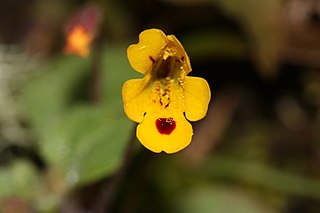
Erythranthe alsinoides is a species of monkeyflower known by the common names wingstem monkeyflower and chickweed monkeyflower. It was formerly known as Mimulus alsinoides.

Erythranthe bicolor, the yellow and white monkeyflower, is a species of flowering plant in the lopseed family (Phrymaceae). It is endemic to California, United States. It was formerly known as Mimulus bicolor.
Diplacus clevelandii is an uncommon species of monkeyflower known by the common name Cleveland's bush monkeyflower. It was formerly known as Mimulus clevelandii.
Erythranthe inflatula, synonyms Mimulus inflatulus and Mimulus evanescens, is a rare species of monkeyflower known by the common name disappearing monkeyflower. It is native to the western United States, where it is known from about ten locations in and around the Great Basin within the states of Idaho, Oregon, and California; it is also found in Nevada. Specimens of the plant had been catalogued as Mimulus breviflorus, but on further examination it was evident that they were a separate, unclassified species; this was described to science in 1995. It is thought that the plant may have evolved via hybridization between Erythranthe breviflora and Erythranthe latidens, or that it evolved from E. latidens and then into E. breviflora.

Diplacus pictus is a species of monkeyflower known by the common name calico monkeyflower.
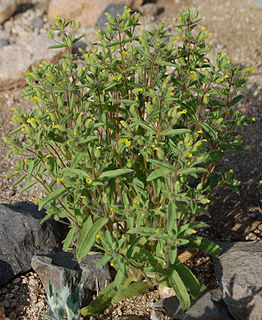
Mimetanthe is a genus of flowering plants in the family Phrymaceae. It has only one species, Mimetanthe pilosa, synonym Mimulus pilosus, known by the common names false monkeyflower and downy mimetanthe. It is native to the western United States and Baja California, where it grows in moist and disturbed habitat types. This plant is different enough from other monkeyflowers that it is treated in its own monotypic genus, Mimetanthe, or it may be retained in Mimulus.
Erythranthe pulsiferae is a species of monkeyflower known by the common names candelabrum monkeyflower and Pulsifer's monkeyflower. It was formerly known as Mimulus pulsiferae. It is native to the western United States from Washington to northern California, where it grows in wet habitat such as streambanks. It is an annual herb growing 2 to 21 centimeters tall. The leaves occur in a basal rosette and oppositely along the stem, each on a short petiole and with an oval blade. The tubular base of the flower is encapsulated in a ribbed calyx of sepals with tiny pointed lobes. The flower is roughly a centimeter long and yellow in color, sometimes with red spotting or pink-tinged white coloration in the mouth.
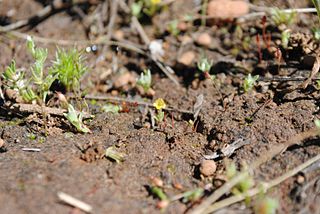
Diplacus pygmaeus is a species of monkeyflower known by the common name Egg Lake monkeyflower.

Erythranthe tilingii is a species of monkeyflower known by the common name Tiling's monkeyflower. It was formerly known as Mimulus tilingii.

Diplacus torreyi is a species of monkeyflower known by the common name Torrey's monkeyflower.
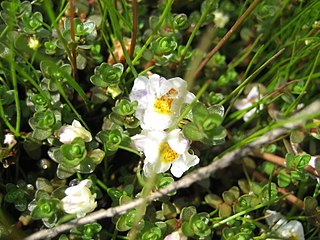
Thyridia repens, with common names creeping monkeyflower, Native musk, Maori musk, and native monkey flower, is a herbaceous succulent plant native to New Zealand and Australia that grows as low mats. Its flowers are light purple or white. It is the only species in the genus Thyridia.

Phryma is a genus of flowering plant in the family Phrymaceae, native to temperate Asia and eastern North America.

Phryma oblongifolia is a species of flowering plant in the family Phrymaceae, native from temperate Asia southwards to the Himalayas and north Vietnam. It was first described by Gen-ichi Koidzumi in 1929. Its status as a separate species was not usually accepted, and it was treated as a variety of Phryma leptostachya. In 2014, the distinctiveness of North American P. leptostachya and Asian P. oblongifolia was supported, based on morphological evidence and a previous molecular phylogenetic study. As of April 2022, the species is recognized by Plants of the World Online.















